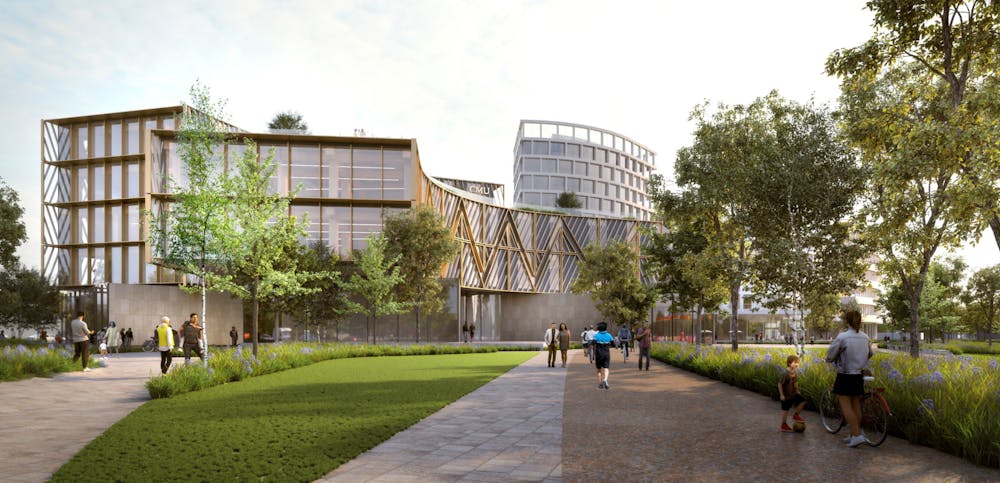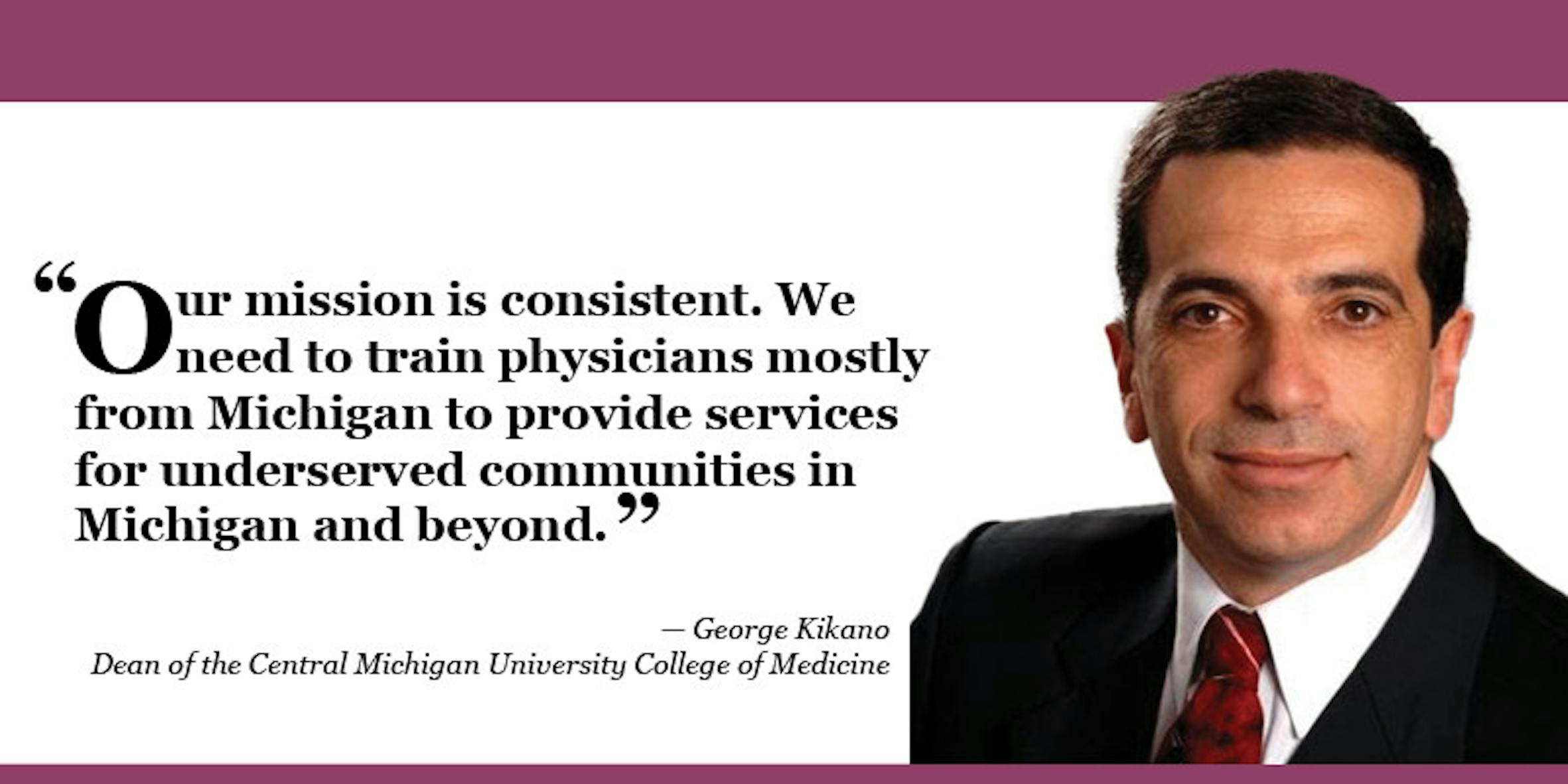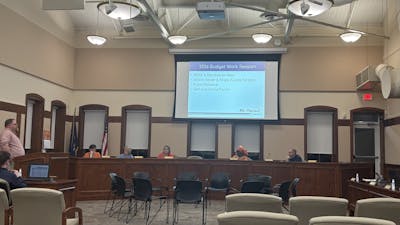'The benefit here is for the whole region'
The CMU Med School plans a move to Saginaw. What impact would that have, here?

The Central Michigan University College of Medicine plans to move its campus to Saginaw.
The new campus will cost $200 million, and aims to move by 2028, CMED Dean Dr. George Kikano said.
“That’s a very bold move,” he said. “That’s an aggressive timeline. It’s an aggressive capital campaign. But the benefit here is for the whole region anywhere from Mount Pleasant all the way to Saginaw.
“This is not just economic impact in Saginaw, this is putting CMU ... on the map.”
What will this move mean for Mount Pleasant?
Kikano said most medical students who are juniors and seniors are already studying on CMU’s campus in Saginaw. The plan is to move freshmen and sophomores there, as well.
That will be about 200 students leaving Mount Pleasant.
“Two hundred students out of 14,000 ... there probably won’t be too much of an (economic) affect as we move those 200 out,” Kikano said.
Mount Pleasant City Manager Aaron Desentz said the city doesn't yet have exact numbers to indicate the economic impact of these students leaving the area.
“People leaving the area means that's money leaving the area,” Desentz said. “At the same time, we're hopeful and optimistic as Central Michigan University's plan is to try to backfill those students in some way, by expanding other programs.”
Kikano said CMU is hoping to introduce new and grow other programs on Mount Pleasant’s campus. In a July 15 article published by CMU News, University President Bob Davies said those programs could be nursing, physician assistant, athletic training and more.
The research facilities will also stay on Mount Pleasant’s campus, Kikano said.
Meanwhile, Kikano said it up to faculty and staff members where to live. Some of them, he said, live in Saginaw already.
Desentz said that CMU in general is the second-largest employer in Mount Pleasant, following the Saginaw Chippewa Indian Tribe’s Soaring Eagle Casino.
Amanda Garrison, president of the CMU Faculty Association, said CMED faculty are not a part of the union and did not sign a faculty contract.
But Garrison said, to her best knowledge, they love Mount Pleasant.
“Faculty live here,” Garrison said. “Faculty spend money here. Faculty have children here, faculty work here. ... We need Mount Pleasant.”
Mount Pleasant needs CMU as well, Desentz said.
“It’s a very impactful organization overall,” he said. “And then you’ve got, let’s say, about 13,000 students that would be affiliated with the college ... their families that come in on a regular basis, any kind of faculty, you’re taking about a significant portion of the population (of Mount Pleasant).”
Desentz said one of the city’s future goals is to connect more with CMU and create learning opportunities for students, such as internships with the city, businesses and other organizations.
“I just want to see a lot of those kinds of things grow because (they) offer students real world experience,” Desentz said. “But then obviously (the university) offers the city the benefit of well-educated young men and women coming in and creating value.”
Garrison said it is important to work with the local community and continue to strengthen the relationship between CMU and Mount Pleasant.
“We have to be together,” she said. “You cannot be separated from the community.”
CMED is moving to Saginaw, in part, to expand the medical program. CMU Trustee Todd Anson said during the June 25 Board of Trustees meeting that the university aims to increase the number of medical students, growing to 150 per class.
He said Saginaw is a good location for medical students because they will have an opportunity to train in the community's hospitals. Those facilities offer more beds than clinics in Mount Pleasant, which is important for education, Anson said.

Why Saginaw?
The idea of CMED was advanced in 2008 by the Board of Trustees, according to the Clarke Historical Library collection. Classes started in August 2013; the first class had 64 students.
The program originally had a rural focus, with a goal to be housed in Health Professions Building and bring CMU increased research funding and prestige.
Kikano said the CMED’s goal is still to train physicians who will then work in underserved communities, but now those communities comprise both rural and urban, such as Saginaw.
Additionally, Kikano said that “Saginaw is not new for us,” and that CMED already works with community partners there to house residency programs.
“Our mission is consistent,” he said. “We need to train physicians mostly from Michigan to provide services for underserved communities in Michigan and beyond. We need to build research, and we have great programs now around rural health.”
According to the CMED 2023 annual report, during the 2022-23 academic year, the college received 7,989 applications and enrolled a 104-student cohort. Of those applicants, 1,4376 students were from Michigan, and 79 of the future doctors (76 percent) came from in-state.
“We have relationships will all providers in the region,” Kikano said. “MyMichigan, obviously, that has hospitals in Alma, Clare, Midland. ... McLaren that has hospitals in Mount Pleasant and Bay City.”
He said the expansion of CMED is also a part of the Saginaw Medical Diamond Project.
“We have a good product,” he said. “We have over 1,000 (in-state) applicants that want to come to Central Michigan Medical School. We don’t have the space and the facilities for them.”
Where will the funding for CMED come from?
CMU already has a building in Saginaw for med school upperclassmen and residency programs, Kikano said. The goal is to construct a brand-new facility that can house the entire program.
CMED is also looking to fund student scholarships and faculty research as part of its capital campaign, Kikano said.
That all will cost $200 million, and Kikano said CMED plans to raise that money in three to four years.
As a matter of comparison, that funding goal is just shy of half CMU’s total operating budget for 2024-25, which the Board of Trustees approved at $443.2 million.
Kikano said the med school is working with community partners to help with fundraising. The capital campaign efforts will start this fall; Kikano declined to comment on alternative plans, should the funding goal fall short.
“I have full confidence that we will be able to raise the funds,” Kikano said. “CMU is in no position (to fund it): There’s six other colleges to support.
“There’s many other programs that are worthy of the investments within CMU. ... We’ll be raising an additional $200 million from outside sources.”
Kikano said this move and expansion of CMED aims to bring recognition and more students to CMU.
According to CMU’s budget, CMED is projected to generate $29,134,855 in revenues this year with expenditures of $28,482,418.
“We have a great vision,” Kikano said. “We have a great mission. ... So far the College of Medicine has an outstanding track record. We are on the map."






